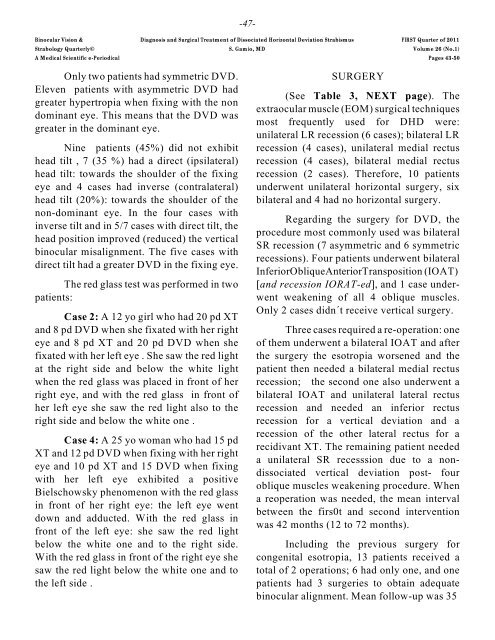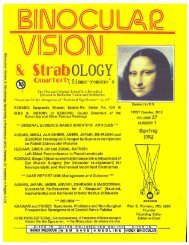Correspondence - ICO Library
Correspondence - ICO Library
Correspondence - ICO Library
You also want an ePaper? Increase the reach of your titles
YUMPU automatically turns print PDFs into web optimized ePapers that Google loves.
-47-<br />
Binocular Vision & Diagnosis and Surgical Treatm ent of Dissociated Horizontal Deviation Strabism us FIRST Quarter of 2011<br />
Strabology Quarterly© S. Gam io, M D Volum e 26 (No.1)<br />
A M edical Scientific e-Periodical Pages 43-50<br />
Only two patients had symmetric DVD.<br />
Eleven patients with asymmetric DVD had<br />
greater hypertropia when fixing with the non<br />
dominant eye. This means that the DVD was<br />
greater in the dominant eye.<br />
Nine patients (45%) did not exhibit<br />
head tilt , 7 (35 %) had a direct (ipsilateral)<br />
head tilt: towards the shoulder of the fixing<br />
eye and 4 cases had inverse (contralateral)<br />
head tilt (20%): towards the shoulder of the<br />
non-dominant eye. In the four cases with<br />
inverse tilt and in 5/7 cases with direct tilt, the<br />
head position improved (reduced) the vertical<br />
binocular misalignment. The five cases with<br />
direct tilt had a greater DVD in the fixing eye.<br />
The red glass test was performed in two<br />
patients:<br />
Case 2: A 12 yo girl who had 20 pd XT<br />
and 8 pd DVD when she fixated with her right<br />
eye and 8 pd XT and 20 pd DVD when she<br />
fixated with her left eye . She saw the red light<br />
at the right side and below the white light<br />
when the red glass was placed in front of her<br />
right eye, and with the red glass in front of<br />
her left eye she saw the red light also to the<br />
right side and below the white one .<br />
Case 4: A 25 yo woman who had 15 pd<br />
XT and 12 pd DVD when fixing with her right<br />
eye and 10 pd XT and 15 DVD when fixing<br />
with her left eye exhibited a positive<br />
Bielschowsky phenomenon with the red glass<br />
in front of her right eye: the left eye went<br />
down and adducted. With the red glass in<br />
front of the left eye: she saw the red light<br />
below the white one and to the right side.<br />
With the red glass in front of the right eye she<br />
saw the red light below the white one and to<br />
the left side .<br />
SURGERY<br />
(See Table 3, NEXT page). The<br />
extraocular muscle (EOM) surgical techniques<br />
most frequently used for DHD were:<br />
unilateral LR recession (6 cases); bilateral LR<br />
recession (4 cases), unilateral medial rectus<br />
recession (4 cases), bilateral medial rectus<br />
recession (2 cases). Therefore, 10 patients<br />
underwent unilateral horizontal surgery, six<br />
bilateral and 4 had no horizontal surgery.<br />
Regarding the surgery for DVD, the<br />
procedure most commonly used was bilateral<br />
SR recession (7 asymmetric and 6 symmetric<br />
recessions). Four patients underwent bilateral<br />
InferiorObliqueAnteriorTransposition (IOAT)<br />
[and recession IORAT-ed], and 1 case underwent<br />
weakening of all 4 oblique muscles.<br />
Only 2 cases didn´t receive vertical surgery.<br />
Three cases required a re-operation: one<br />
of them underwent a bilateral IOAT and after<br />
the surgery the esotropia worsened and the<br />
patient then needed a bilateral medial rectus<br />
recession; the second one also underwent a<br />
bilateral IOAT and unilateral lateral rectus<br />
recession and needed an inferior rectus<br />
recession for a vertical deviation and a<br />
recession of the other lateral rectus for a<br />
recidivant XT. The remaining patient needed<br />
a unilateral SR recesssion due to a nondissociated<br />
vertical deviation post- four<br />
oblique muscles weakening procedure. When<br />
a reoperation was needed, the mean interval<br />
between the firs0t and second intervention<br />
was 42 months (12 to 72 months).<br />
Including the previous surgery for<br />
congenital esotropia, 13 patients received a<br />
total of 2 operations; 6 had only one, and one<br />
patients had 3 surgeries to obtain adequate<br />
binocular alignment. Mean follow-up was 35









